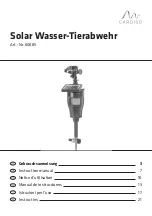
4
Tr
ou
bl
es
ho
ot
in
g
Ti
ps
Co
ns
um
er
S
up
po
rt
In
st
al
la
tio
n
In
st
ru
ct
io
ns
Sa
fe
ty
In
st
ru
ct
io
ns
O
pe
ra
tin
g
In
st
ru
ct
io
ns
Specification guidelines.
The system makes a good supply of drinking water each day.
How much it will make depends primarily on these things…
Incoming Water pH
WATER SOFTENER RECOMMENDED
INCOMING WATER HARDNESS (GPG)
60
50
40
30
20
10
8
6
7
7.5
6.5
Water Softener
not required
Maximum turbidity (NTU)
...............................................<2
Maximum iron, manganese, hydrogen sulfide (ppm)
....................<0.1
Chlorine in water supply
...............................................2.0ppmMaximumallowable
Feed water ph limits (ph)
...............................................4–10
Storage tank capacity—gallons
........................................4
c
Automatic shutoff control
..............................................yes
Prefilter and postfilter
.................................................(fQROPf)carbonBlock
Reverse Osmosis membrane
...........................................(fQROMf)thinfilmPolyamide
Storage Tank Dimension (inches)
.......................................
height
15”
diameter
11”
System Body Dimension (inches)
.......................................
height
11”
width
10.5”
depth
4”
Feed water pressure limits—pounds per square inch (psi)
......................40–120
a
Feed water temperature limits—minimum/maximum degrees F
...............40–100
Maximum Total Dissolved Solids (TDS)—parts per million (ppm)
................2000
Maximum water hardness @ 6.9 ph recommended to optimize membrane
life—grains per gallon (gpg)
......................................................10
forwaterwithhardnessgreaterthan10grains(at6.9pH),theuseofa
softenerisrecommended.failuretoinstallawatersoftenerwillreduce
thelifeoftheReverseOsmosismembrane.seechartforadditional
informationonthepossibleneedforawatersoftener.
a. If house water pressure is over 80 psi, install a pressure reducing valve in the water supply line. If house water pressure
is under 40 psi, install a Reverse Osmosis booster pump (contact your local plumbing supply company).
b. Removed (maximum of 2.0 ppm) by the Reverse Osmosis prefilter.
REGuLaRMaINtENaNcEIsREQuIRED
. Chlorine will destroy
the Reverse Osmosis membrane.
c. Theoretical tank capacity. When tested according to NSF/ANSI Standard 58 at 50 psig inlet pressure, tank capacity is
2.3 gallons.
Содержание PNRQ20RBL
Страница 26: ...Parts list 26 PNRQ20RBL PNRQ21RBN PNRQ21RRB ...
Страница 54: ...Liste de pièces 54 PNRQ20RBL PNRQ21RBN PNRQ21RRB ...
Страница 56: ...Fonctionnement Mesures de sécurité Installation Conseils de dépannage Soutien au consommateur 56 Notes ...
Страница 83: ...83 Soporte al consumidor Solucionar problemas Operación Seguridad Instalación Notas ...
Страница 84: ...Lista de partes 84 PNRQ21RBN PNRQ21RRB ...





































